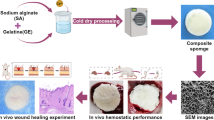Abstract
In this study we prepared tissue-adhesive hemostatic glue and assessed hemostatic effects on hepatic bleeding animal model. Alginate was used as primary polymer for the fabrication of hemostatic glue, oxidized for the introduction of the tissue-adhesive Schiff base forming aldehyde and then encoded with mussel-inspired dopa. In addition, polyallylamine (PAA) was selected for as an intra-structuring polymer which ensures the gel strength and allows instantaneous glue formation on the bleeding spot. Primary glue (OA glue) was quickly formed within 5 to 10 seconds after the mixing oxidized alginate (OA) with PAA. The degree of oxidation and the mixing ratio of OA and PAA were precisely determined based on glue formation time and gel strength. And the extend of dopa conjugation on OA was determined by the tissue adhesion force and the elasticity of the glue (Dopa-OA glue). Especially, elasticity of Dopa-OA glue was significantly enhanced after introduction of dopa to OA. Functional assay of Dopa-OA glue on hepatic bleeding animal model showed much enhanced hemostatic action. Dopa-OA glue is expected to provide novel injectable tissue adhesives for the treatment of hemorrhage caused by clinical procedures or trauma.

Similar content being viewed by others
References
J. F. Kelly, A. E. Ritenour, D. F. McLaughlin, K. A. Bagg, A. N. Apodaca, C. T. Mallak, L. Pearse, M. M. Lawnick, H. R. Champion, and J. B. Holcomb, J. Trauma, 64, S21 (2008).
L. Montanaro, C. R. Arciola, E. Cenni, G. Ciapetti, F. Savioli, F. Filippini, and L. A. Barsanti, Biomaterials, 22, 59 (2001).
P. Ferreira, R. Pereira, J. F. J. Coelho, A. F. M. Silva, and M. H. Gil, Int. J. Biol. Macromol., 40, 144 (2007).
D. M. Toriumi, K. O'Grady, D. Desai, and A. Bagal, Plast. Reconstr. Surg., 102, 2209 (1998).
S. Canonico, Acta Biomed., 74, Supple 2:21 (2003).
K. H. Siedentop, J. J. Park, A. N. Shah, T. K. Bhattacharyya, and K. M. O'Grady, Am. J. Otolaryngol., 22, 230 (2001).
R. Bitton and H. Bianco-Peled, Macromol. Biosci., 8, 393 (2008).
O. Jeon, J. E. Samorezov, and E. Alsberg, Acta Biomater., 10, 47 (2014).
A. B. Lansdown and M. J. Payne, J. R. Coll. Surg. Edinb., 39, 284 (1994).
A. Sank, M. Chi, T. Shima, R. Reich, and G. R. Martin, Surgery, 106, 1141 (1989).
C. M. Gao, M. Z. Liu, J. Chen, and X. Zhang, Polym. Degrad. Stab., 94, 1405 (2009).
K. H. Bouhadir, K. Y. Lee, E. Alsberg, K. L. Damm, K. W. Anderson, and D. J. Mooney, Biotechnol. Prog., 17, 945 (2001).
B. Balakrishnan and A. Jayakrishnan, Biomaterials, 26, 3941 (2005).
J. H. Ryu, Y. Lee, W. H. Kong, T. G. Kim, T. G. Park, and H. Lee, Biomacromolecules, 12, 2653 (2011).
S. H. Baik, J. H. Kim, H. H. Cho, S. N. Park, Y. S. Kim, and H. Suh, J. Surg. Res., 164, E221 (2010).
Y. Lee, H. J. Chung, S. Yeo, C. H. Ahn, H. Lee, P. B. Messersmith, and T. G. Park, Soft Matter, 6, 977 (2010).
H. Zhao and N. D. Heindel, Pharm. Res., 8, 400 (1991).
X. M. Mo, H. Iwata, S. Matsuda, and Y. Ikada, J. Biomater. Sci. Polym. Ed., 11, 341 (2000).
D. S. Jones, C. R. Irwin, A. D. Woolfson, J. Djokic, and V. Adams, J. Pharm. Sci., 88, 592 (1999).
D. S. Jones, A. D. Woolfson, A. F. Brown, W. A. Coulter, C. McClelland, and C. R. Irwin, J. Control. Release, 67, 357 (2000).
D. S. Jones, M. L. Bruschi, O. de Freitas, M. P. D. Gremiao, E. H. G. Lara, and G. P. Andrews, Int. J. Pharm., 372, 49 (2009).
Y. Murakami, M. Yokoyama, H. Nishida, Y. Tomizawa, and H. Kurosawa, Colloids Surf. B: Biointerfaces, 65, 186 (2008).
Y. Murakami, M. Yokoyama, H. Nishida, Y. Tomizawa, and H. Kurosawa, J. Biomed. Mater. Res. Part B: Appl. Biomater., 91B, 102 (2009).
J. D. Ferry, E. R. Fitzgerald, L. D. Grand, and M. L. Williams, Ind. Eng. Chem., 44, 703 (1952).
S. Hong, K. Yang, B. Kang, C. Lee, I. T. Song, E. Byun, K. I. Park, S. W. Cho, and H. Lee, Adv. Funct. Mater., 23, 1774 (2013).
Author information
Authors and Affiliations
Corresponding author
Additional information
Acknowledgments: This research was supported by Civil Military Co-Technology Development Program from Civil Military Technology Cooperation Center (16-CM-SS-07), and by Korea Research Fellowship Program and Basic Science Research Program through the National Research Foundation of Korea (NRF) funded by the Ministry of Science and ICT (NRF-2017R1A2A2A07001272, 2017R1A6A3A11035722, 2017R1D1A1B03035654, 2016H1D3A1938159 and 2018R1A6A1A03025523), and partly supported by WCSL (World Class Smart Lab) research grant directed by Inha University.
Electronic supplementary material
Rights and permissions
About this article
Cite this article
Song, C.K., Kim, MK., Lee, J. et al. Dopa-Empowered Schiff Base Forming Alginate Hydrogel Glue for Rapid Hemostatic Control. Macromol. Res. 27, 119–125 (2019). https://doi.org/10.1007/s13233-019-7026-3
Received:
Revised:
Accepted:
Published:
Issue Date:
DOI: https://doi.org/10.1007/s13233-019-7026-3




